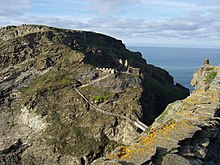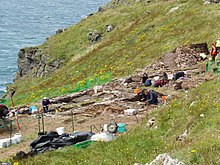Tintagel Castle
Castle Tintagel [tɪntædʒəɫ] ( English : Tintagel Castle , Cornish : Kastell Dintagell = fortress of the narrow access) is located on a peninsula on the west coast of Cornwall , near the village of Tintagel removed. Steep entrances and exits lead to it, it is only connected to the mainland by a narrow headland. In the legend it is connected with the procreation of the mythical King Arthur ( English : Arthur ).
legend
According to the Arthurian legend , which was essentially written by Geoffrey of Monmouth in the 1130s, the conception of King Arthur took place in Tintagel . In the days of Uther Pendragon , Tintagel Castle belonged to a certain Gorlois , the Duke of Cornwall. This is where Gorlois hid his wife, Igraine , whom Uther desired for herself. In order to be able to approach Igraine unnoticed, Merlin made him look like a duke. The plan worked and Igraine received the future King Arthur.
In the Tristan legend, Tintagel is King Markes' castle and an important scene of action.
The late antique-early medieval complex
In Tintagel there is hardly any evidence of pre-Roman and Roman settlement. It is possible that a trade route past Tintagel existed in Roman times, which could be indicated by two Roman milestones from the area.
The first older excavations took place under CA Ralegh Radford (Ministry of Works) in the 1930s. If the focus was initially on the "search for King Arthur", Radford finally reinterpreted the place as an "early Christian Celtic monastery" from the 5th to 8th centuries.
More recent excavations between 1990 and 1999, due to the great abundance and high quality of the imported material found (partly from the eastern Mediterranean and Spain) and the building structures encountered, meanwhile rather suggest an important "princely seat" with a central local function, which presumably from the It existed from the middle of the 5th century to the beginning of the 7th century and in which efforts were made to hold on to Roman-ancient traditions as well as to contacts with the Mediterranean region.
A piece of slate excavated in 1998 with a late antique Latin inscription ("PATER ... COLIAVIFICIT ... ARTOgNOV ... COLI FICIT") points less to the presence of the mythical King Arthur than to the continued existence of Latin script and late antique culture in southern England.
The high medieval complex
In May 1233, Richard of Cornwall , a younger brother of the English King Henry III. , the castle site in exchange for three of his estates. Probably inspired by the Arthurian legend written in the 12th century, he had a new castle built. Richard of Cornwall had been named Earl of Cornwall in 1227 and probably wanted to consolidate his rule in south-west England by invoking the tradition of Arthur, who was popular at the time through legend. The small and only relatively weakly fortified complex was located away from the medieval trade routes and shipping connections, which meant that it had little military and strategic value. Richard of Cornwall also rarely used the castle. In 1242 he received the Welsh prince Dafydd ap Llywelyn in the castle. Soon after it was built, however, the walls of the exposed castle were considered unstable, and in 1337 it was declared dilapidated. The heir to the throne Edward of Woodstock , who had been made Duke of Cornwall in 1337, had the castle restored and the high-medieval living hall replaced with smaller buildings. At the end of the 14th century, the facility was used as a prison for high-ranking prisoners. In 1583 it was recommended to fortify the peninsula against attacks from the sea, but by 1600 the castle was finally abandoned and fell into disrepair.
investment
Hardly any remains of the early medieval complex have survived, as the complex was built over by the high medieval castle. There are other earth walls in front of the castle, the dates of which were not exactly known. The high medieval castle consisted of a bailey on the mainland and the main castle on the peninsula in front , which is connected to the mainland by a narrow land bridge. The outer bailey was in turn divided into a lower and an upper courtyard on a cliff. The lower courtyard served as the entrance to the castle, while the upper courtyard contained various smaller buildings. Access to the main castle also led from the lower courtyard. This access was fortified by a ditch that had already been dug in the early Middle Ages, and probably by a high medieval gatehouse, of which, however, no remains have survived due to coastal erosion . Today only a few remains of the wall remain from the castle. Due to its location, the complex was only small, and the walls were narrow compared to other medieval complexes. The main castle contained a living hall, which was laid out on an artificially created terrace, as well as other living rooms. At the northern end of the peninsula there were other buildings in the High Middle Ages, including a round structure that was probably used as a granary. This proves that the small peninsula was probably used for agricultural purposes at times in the High Middle Ages. At the highest point of the peninsula was a chapel dedicated to St Juliot, a local saint. The existing wall remains were obviously built together with the high medieval castle, but the separate location and several graves carved into the rock indicate that the origin of the chapel is much older. Around the chapel are the remains of several buildings that were apparently built at different times. North of the main castle is the only mooring possibility on the peninsula, which was secured by a wall with a gate, the so-called Iron Gate .
Both on the area of the outer bailey and, above all, on the area of the main castle, fragments of early medieval clay pots that originally came from the Mediterranean region were found during excavations. The center of the early medieval complex was probably on the site of the high medieval main castle, as a particularly large number of pottery shards were found there. In the wider area of the peninsula, however, there are remains of early medieval, rectangular huts, most of which apparently only served as temporary homes. Some of the walls of these huts were restored after excavations in the 1930s, but most of the remains were uncovered by a 1983 forest fire.
In 2018, the construction of a new pedestrian bridge began, which will connect the peninsula to the mainland at the height of the medieval entrance.
literature
- Barrowman, R.-Batey, C.-Morris, C .: Excavations at Tintagel Castle 1990-1999 . Oxford 2007.
Web links
- http://www.archaeology.co.uk/ca/timeline/saxon/tintagel/tintagel.htm (English page on archeology)
- https://www.english-heritage.org.uk/visit/places/tintagel-castle official site of English Heritage
Individual evidence
- ^ Tintagel Castle definition and meaning | Collins English Dictionary. Accessed August 22, 2018 (English).
- ^ English Heritage: Richard of Cornwall, King Arthur and Tintagel Castle. Retrieved May 6, 2017 .
- ^ English Heritage: History of Tintagel Castle. Retrieved May 6, 2017 .
Coordinates: 50 ° 40 ′ 7.5 ″ N , 4 ° 45 ′ 43 ″ W.



